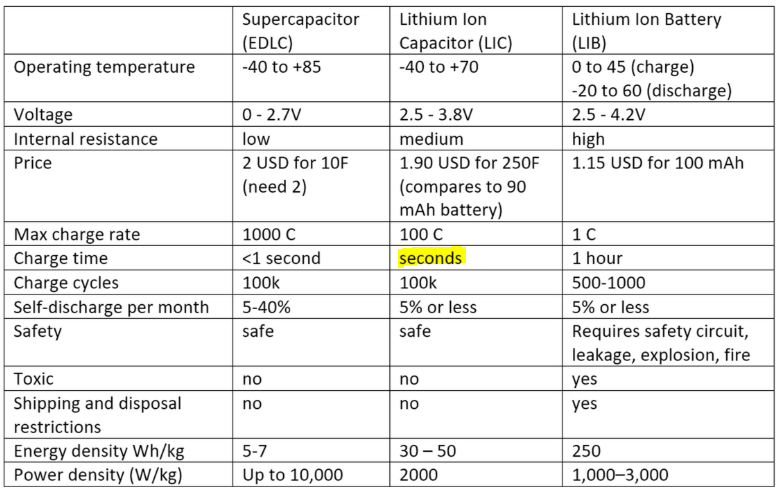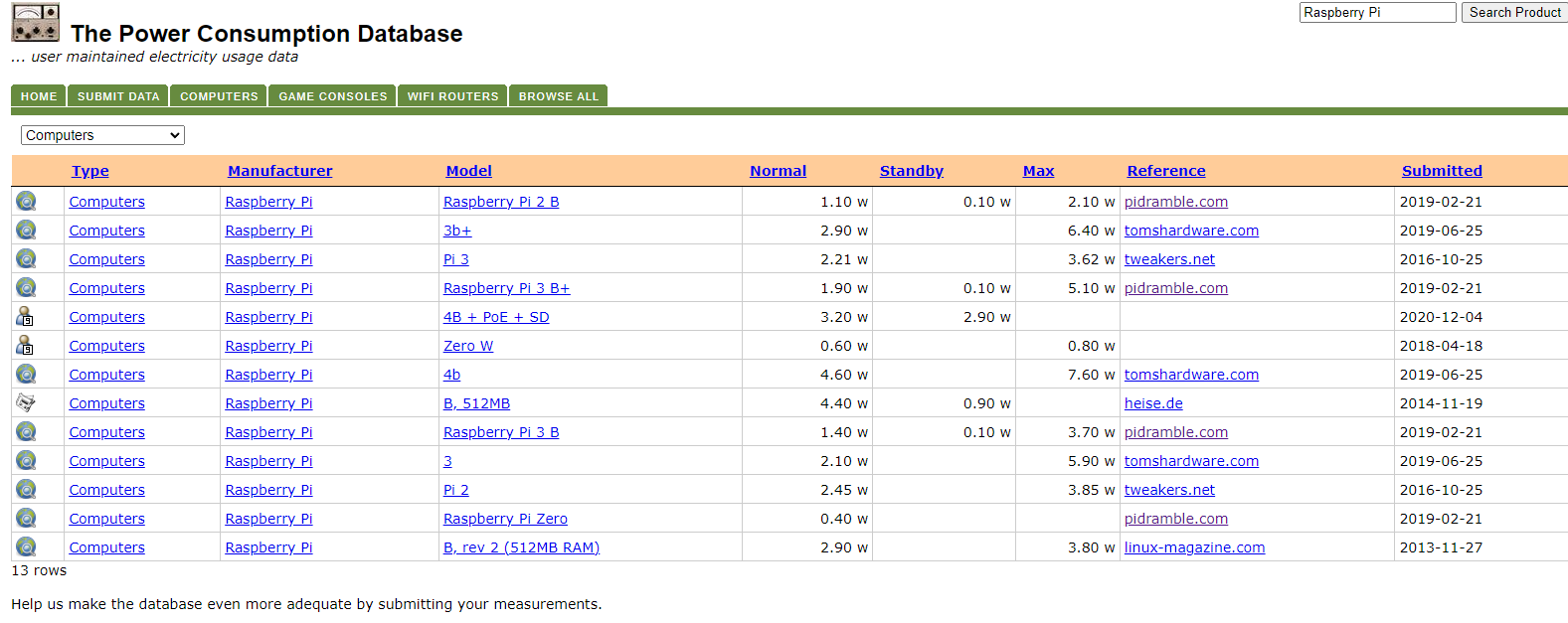https://www.newark.com/vinatech/vel08203r8306g/lithium-ion-capacitor-30f-3-8v/dp/38AJ2228
https://www.tindie.com/products/jaspersikken/solar-harvesting-into-li-ion-battery/ :

from https://www.jeffgeerling.com/blogs/jeff-geerling/raspberry-pi-zero-power:
"In the past, for the Pi Dramble project, I've measured power consumption for all the other Pi models I own (A+, B+, and model 2), so I thought I'd use my PowerJive USB Power Meter to measure the usage for the Zero for comparison:
| Pi Model | Pi State | Power Consumption |
|---|---|---|
| A+ | Idle, HDMI disabled, LED disabled | 80 mA (0.4W) |
| A+ | Idle, HDMI disabled, LED disabled, USB WiFi adapter | 160 mA (0.8W) |
| B+ | Idle, HDMI disabled, LED disabled | 180 mA (0.9W) |
| B+ | Idle, HDMI disabled, LED disabled, USB WiFi adapter | 220 mA (1.1W) |
| model 2 B | Idle, HDMI disabled, LED disabled | 200 mA (1.0W) |
| model 2 B | Idle, HDMI disabled, LED disabled, USB WiFi adapter | 240 mA (1.2W) |
| Zero | Idle, HDMI disabled, LED disabled | 80 mA (0.4W) |
| Zero | Idle, HDMI disabled, LED disabled, USB WiFi adapter | 120 mA (0.7W) |
As you can see in the table above, the Zero uses a similar amount of power as the long-time power-sipping champ, the A+—both use less than half the power of any other more fully-equipped Pi. This is no doubt due to the lack of extra ports and circuits that are active on the Pi itself. This means that a small battery pack (say, a flat Li-Ion pack rated at 1,400 mAh) should last well over 4 hours, even if you have moderate activity while using a cheap USB WiFi dongle!"
My other project is a deliberation page to establish an interoperable standard, so it is more of a place to post links and concepts that could be used as candidate components. Some of these links and tables are posted on that page as well, but this page is designed to focus on a specific test to complement that project. It is based on PowerFilm Solar's Bluetooth Beacon test, that used small solar panels to routinely charge a capacitor (within seconds), which would then power a microcontroller that would send a bluetooth signal:
In this project, I am replacing the bluetooth beacon with a Raspberry Pi Zero. Ideally, I could use a single 5V Li-Ion Capacitor to power the Raspberry Pi Zero, rather than two 2.5V-3.7V ones (which may cause the operating voltage to exceed 5.5V!)
Another ideal would be to design a Single Board computer/embedded motherboard with a Cortex-A processor -application series such as the ARM11-based Raspberry Pi Zero, but powered by dual supply voltages, similar to the SparkFun Artemis (3.3V and 5V).
The theory is, that if a Li-Ion Capacitor (LIC) is rated for 100K cycles, then, even 10 recharges a day would suggest it could last 25+ years. Using daylight, there are typically 6-8 hours of sunlight on a good day. Timing and designing an SBC with an appropriately sized LIC would allow it to minimize the need for excess capacity (e.g. a 250F/90mAh equivalent) and use a 150F capacity LIC- i,e. 54mAh. If one wanted to recharge it only 8 times a day, assuming the LIC with a solar panel and charge manager would need only seconds in sunlight, it would only need to be charged once an hour. 365 days a year, for 25 years is 73,000 charge cycles. Obviously no one would see the need to have that regiment, but it gives a ballpark idea of what is possible. 54mAh is also means a device running at 54mA can only run for one hour. A Sparkfun Artemis idling is going to use around .9mA thus it can run consistently for over 54 hours (2 days+) on just 150F.
A Raspberry Pi Zero in idle, with LED and HDMI disabled uses around 80mA. That means on a 150F (54mAh) LIC, it will only last 40.5 minutes. Idling, especially without peripherals such as USB & Wifi, won't be very practical, but that will be examined later.
from https://www.tpcdb.com/list.php?page=1&order=1&sort=manufacturer&type=13&query=Raspberry+Pi:

The Pi Zero in Active state uses around 0.5W (100mA, or 500mW). On a 54mAh "battery" (LIC), that's 32.4 minutes. On a 30F (11mAh, that's only 6.6 minutes). Plenty time to save information to preserve microSD power interruptions and possible corruption of data, but not much time to use the system. As mentioned above, 120mA is the consumption in idle with a USB Wifi adapter. Thus it will last less than 6 minutes. and probably less, since 100mA is the bare board. At maximum consumption, it will consume 350mA (see chart below). That's only 1.88 minutes on a 30F and only 15.4 minutes on 250F.
A 250F capacitor (the largest by Vinatech), is 90mAh, which means powering a 100mAh system only provides 54 minutes. There are 750F LICs made by other manufacturers, but they are too large for a laptop and will not be considered here. Combining three in series the size of C Batteries is not my intention, but I know a laptop hinge could handle that.
So there is a practical workspace with Lithium Ion Capacitors as mobile motherboard batteries if a small enough and low power enough system can be designed to be easily swappable as safer possibly denser LICs and alternative, Sodium Ion Capacitors get developed using a standard 3.3V supply. While 5V is certainly beneficial it only takes 3.3V to power a light application processor by RISC-V or ARM Cortex A. It doesn't technically need 5V, except out of the convenient USB chargers.
Thus, a single LIC would actually serve as a very useful uninterruptable power supply (UPS) backup for a Raspberry Pi, where past projects use multiple capacitors or very large supercapacitors (using one to two 400F ones). With that said, it would be worth while to explore boards that already include a 3.3V pin for power input in the GPIO header. The standard Pi Zero does not include it, but it can be soldered or hammer headed on (mine was hammer headed diagonally and incompletely without the, ahem, hammer, and only marginally useful- but that is a tangential story for some other time).
The goal here is to try to get the Rpi Zero to boot up to an OS userspace, connected externally powered HDMI screen, and to see if it can open a Leafpad application, save, and then fully shutdown before the LIC runs out of power.
Another low power board is the more advanced, Quad core Cortex A35-based RK3308 in the RockPi S, which I also have. With 4 cores, it is certainly quick- perfect for running a Ruby on Rails database/server or what have you, but of course the smaller 28nm node-compared to the 65nm-based Pi Zero on the Broadcom BCM2835 chipset (some say 40nm). Yes, I know the Pi Zero 2W, which uses a Broadcom BCM2710A1 is a newer 4 core Arm Cortex-A53 @ 1GHz based on the 40nm chip:
"The BCM2710A1 uses the 40nm silicon technology node (as opposed to the 28nm node which Pi 4 & Pi 400 use)."
The consumption: https://www.cnx-software.com/2021/12/09/raspberry-pi-zero-2-w-power-consumption/ (around 500-600mW).
Despite using smaller transistors, it is clocked to use more power than the 1st gen, 0.4W Pi Zero. Because it adds 3 cores to the Rpi's lowest cost chip, Rpi decided performance was more important than minimizing power consumption at cost, and as the article points out, manufacturing at 28nm would have been prohibitive. It could be said that the minor jump from 65nm to 40nm wasn't significant for power consumption (even disabling 3x cores doesn't show much decrease). Spending an extra 10-$15 on a wireless Pi0 2W isn't something most people are going to complain about. Different markets, anyways.
David Boddie pointed me to this article by Jeff Geerling, which tested the power consumption of a Pi 0 2W after disabling two of the four cores: https://www.jeffgeerling.com/blog/2021/disabling-cores-reduce-pi-zero-2-ws-power-consumption-half
""and sure enough, the power consumption averaged 200 mA (less than half of the 4-core reading), spiking only as high as 260 mA, so less than 1.3W."
From the official RPi Github:
Typical power requirements
| Product | Recommended PSU current capacity | Maximum total USB peripheral current draw | Typical bare-board active current consumption |
|---|
Raspberry Pi Zero | 1.2A | Limited by PSU, board, and connector ratings only | 100mA |
Raspberry Pi Zero W | 1.2A | Limited by PSU, board, and connector ratings only. | 150mA |
Raspberry Pi Zero 2 W | 2A | Limited by PSU, board, and connector ratings only. | 350mA |
(I have modified the following table with bold to highlight the Pi Zero Column):
The following table describes the amount of power (in amps) drawn by different Raspberry Pi models during various workloads:
Raspberry Pi 1B+ | Raspberry Pi 2B | Raspberry Pi 3B | Raspberry Pi Zero | Raspberry Pi 4B | ||
Boot | Max | 0.26 | 0.40 | 0.75 | 0.20 | 0.85 |
Avg | 0.22 | 0.22 | 0.35 | 0.15 | 0.7 | |
Idle | Avg | 0.20 | 0.22 | 0.30 | 0.10 | 0.6 |
Video playback (H.264) | Max | 0.30 | 0.36 | 0.55 | 0.23 | 0.85 |
Avg | 0.22 | 0.28 | 0.33 | 0.16 | 0.78 | |
Stress | Max | 0.35 | 0.82 | 1.34 | 0.35 | 1.25 |
Avg | 0.32 | 0.75 | 0.85 | 0.23 | 1.2 | |
Halt current | 0.10 | 0.055 | 0.023 |
Thus, the Pi Zero doesn't use more than 1.8 watts at 100% utilization, and typically less than 1 watt. Tall order for Li-ion capacitor!
Thus, setting a 100mA consumption limit can significantly extend the "battery" life of an LIC. Running a 200mA Pi Zero or Pi 0 2W on a 150F will last a little over 20 minutes, as a headless server- not one connected to several peripherals. But it sure beats expensive and exotic UPS systems.
 Giovanni
Giovanni